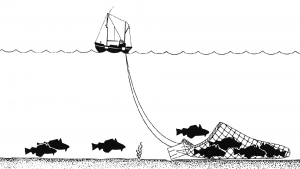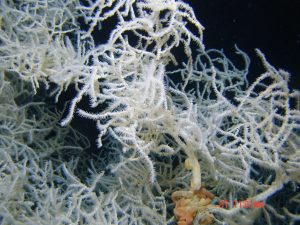Coral reefs around the world are changing. Human’s detrimental impact on the world’s reefs through nutrient runoff, ocean acidification, physical damage, and rising sea temperatures and levels are threatening the diversity and even existence of many coral reefs. While this is readily apparent in many shallow water reefs, the hidden deep water reefs sites might be even more danger than their shallow cousins due to a combination of harsh conditions and low awareness about damage caused by human actions.
Coral reefs of all kinds around the world are vital sites for conservation and deep water reefs are no exception. Deep water reefs share many of the benefits that shallow water reefs are acclaimed for such as homes for many commercially harvested fish, producing compounds that are used in modern medicine for their anti-viral and anti-inflammatory properties, and serving as habitat for huge amounts of biodiversity. In addition, deep water reefs have some unique benefits of their own. For one, deep water reefs are old. Not old like your grandfather or even like the United States, but old like the use of bronze tools. Coral colonies have been recorded at over 4,000 years old and the reef skeletons they leave behind can be many many times that. This gives the deep water coral Leiopathes glaberrima the title of oldest marine organism on record and gives scientists an excellent way to study past conditions. For as these corals grow and build the reef they leave little rings in the structure around them. These rings, similar to the rings in the trees, can tell scientists about the temperature, salinity, and nutrients available in the ocean thousands of years ago. This information on ocean conditions so long ago is invaluable, especially in a time where it is more and more crucial to understand how ocean’s temperatures can change over millennia. Protecting these reefs in order to preserve the potential for large amounts of scientific data is paramount especially in the face of mounting threats against deep water reefs1,2,5.
Of all the threats on deep water coral reefs, the greatest one is pure physical damage. These deep water reefs live in temperatures as low as 4C with no light for photosynthetic activity and must snatch what nutrients and food there is floating around in the ocean depths. These conditions mean that these reefs grow at a rate that’s best measured in mm per year. So when an errant chain or anchor plows through a field of deep sea coral, its destroying not years but millennia of work. And nothing damages these corals more often or more heavily than deep sea fishing trawlers1,4.

A diagram of a trawling net at work. The heavy doors in front of the net cause scarring by dragging over and through reef material.
By NOAA – https://commons.wikimedia.org/wiki/File:Trawling_Drawing.jpg?uselang=ru, Public Domain, https://commons.wikimedia.org/w/index.php?curid=34858559
Fishing trawlers work by dragging nets along the ocean floor in order to catch fish that may inhabit the lower depths of the ocean. These nets can go up to 1500m (~5000ft) deep, and often favor the continental shelf regions that are so valuable for deep water reefs. Their conical nets are held open by heavy beams or doors and may be weighed down with large wheels or chains. The structures that weigh these nets down to the bottom, whether they be gates, wheels, or just iron or lead weights, can cause catastrophic damage to deepwater reefs, leading to huge scars through reefs. Countries such as the United Kingdom and Norway have already enacted legislation to protect known reef areas from fishing activities that heavily damage the sites, and many more are attempting to follow their lead. In order to curtail damage to these reefs, and let them begin the long, slow process of healing we need to both direct efforts to finding these elusive deep water sites, as well as protect them from damaging activities3,6.
- Roberts JM (2006) Reefs of the Deep: The Biology and Geology of Cold-Water Coral Ecosystems. Science 312:543–547.
- Rogers AD (1999) The Biology of Lophelia pertusa (Linnaeus 1758) and Other Deep-Water Reef-Forming Corals and Impacts from Human Activities. International Review of Hydrobiology 84:315–406.
- Freiwald, A (2004) Cold-water coral reefs: Out of sight – No longer out of mind. UNEP report.
- Svensen, E. Coral reefs: Cold water corals. WWF. http://wwf.panda.org/about_our_earth/blue_planet/coasts/coral_reefs/coldwater_corals/
- Ocean Portal. Deep Sea Corals. Smithsonian Museum of Natural History http://ocean.si.edu/deep-sea-corals
- Rogers A (2004) The Biology, Ecology and Vulnerability of Deep-Water Coral Reefs. IUCN. https://cmsdata.iucn.org/downloads/alexrogers_cbdcop7_deepwatercorals_complete.pdf


